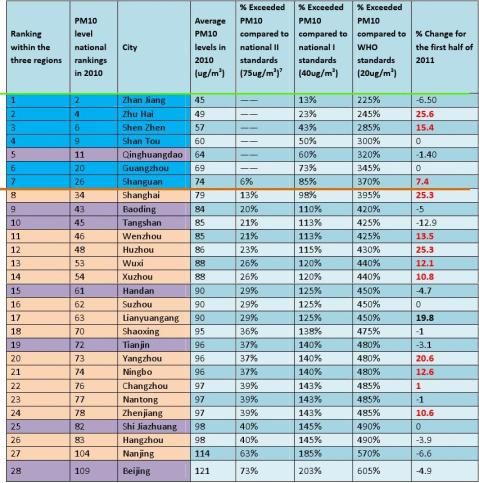国内汽车空气质量报告
国内汽车空气质量报告
《报告》揭示的真相
在国内,前不久中国科学院所属中科理化环境分析研究中心通过对50台车型样本的测试,得出了一份极具参考价值的权威报告——《国内汽车空气质量报告》。该报告让我们第一次完整了解到目前国内汽车空气质量的状况极其不容乐观。
此次测试中选用的车型,其行使里程从1万公里到27万公里不等,涵盖了市场上各级别主流车型。测试主要针对空气中TVOC含量、菌落总数以及可吸入颗粒物进行,结果显示,TVOC含量与室内空气质量标准比较平均超标30%,菌落总数和室内环境质量评价标准1级参照对比平均超标77.65%,与新加坡室内空气质量标准比较平均超标255.30%! 各种危害后患无穷
我们来详解下这些.cn空气污染物的来源以及会造成的危害。TVOC是指总挥发性有机化合物,其来源多种多样。室内环境专家认为,空气中的一氧化碳、二氧化碳、氮氧化合物等都会随着空调外循环系统进入车内;另外车内本身的装饰物会挥发出各种化学其他,首当其中的则是http://www.epb.cc甲醛。
世界卫生组织(WHO)、美国国家科学院/国家研究理事会(NAS/NRC)等机构一直强调TVOC是一类重要的空气污染物。它拥有极强的毒性、刺激性,其严重程度可以导致癌性的发生。长期接触,会影响人体皮肤和黏膜,从而引起机体免疫水平失调,影响中枢神经系统功能,使人出现头晕、头痛、嗜睡、无力、胸闷等自觉症状;还可能影响消化系统,出现食欲不振、恶心等,严重时可损伤肝脏和造血系统。
再来看看车内空气的菌落,其中领“菌”人物便是臭名昭著的金黄色葡萄球菌以及大肠杆菌,部分车型还有霉菌、绿脓杆菌和肺炎链球菌等。这些细菌有的会滋生在空调系统里,有的会随着乘员进入车内。在空调、仪表盘、地毯、方向盘、坐垫、门拉手、后备箱、座位、排挡杆、中控台、收音机都部位,都是细菌的集中地。换句话说,坐在车里的我们已经细菌包围了!
关于它们的危害,都已是老生常谈。就拿比较多见的金黄色葡萄球菌来说,会让人不知不觉中患上扁桃体炎、气管炎等呼吸道疾病,严重的话甚至会引起葡萄球菌性肺炎慢性肺炎、慢性肺囊肿,有大量脓性痰,很有可能最终引发毒血症。这可不是危言耸听,恰恰相反,这只是细菌危害中的冰山一角。
其实无论TVOC还是细菌的滋生,都有一个共同之处,那就是车主没有定期地对汽车空调系统进行清洗维护。正常有效的清洗空调,可降低车内空气污染度80%。车主们也许会用一两件空调清洗产品来进行保养,其实这个过程不是靠单一的产品就能解决,我们需要的是一整套最终解决方案。
车内空气解决之道,你值得拥有
车内空气污染虽如洪水猛兽,但也并不是无法对抗。关键找准问题所在。解决之道不外乎人与车。
一方面在于人的用车习惯,日常驾驶当中做到“三拒绝”。
第一:拒绝下雨天湿气进入车内,保持门窗关闭;
第二:拒绝食物残渣滞留车内腐烂,避免滋生细菌;
第三:拒绝车内吸烟,防止恶化车内空气;
另一方面在于汽车空气养护意识,养成定期清洁车内空气的习惯,坚持做到“两清洗”,为了更好的帮助大家了解“两清洗”,以目前汽车空气清洁维护市场当中处于领先地位的上海世博会使用产品为例。
第一:清洗汽车空调
我们已经知道,清洗汽车空调可以大幅度降低车内.cn空气污染。汽
车空调“抗菌清新”的程序必不可少。在这方面,车主在日常空调保养清洗的同时可以选用汽车纳米除味剂对车内的空间进行喷洒式使用。
另外,建议作为常用产品,养成每日对空调出风口清洗和喷洒杀菌的习惯,效果更佳。
第二:清洗车内甲醛
尤其新车,车内甲醛含量经常超标,清洗之后经过一段时间甲醛指数又会上升,所以车主们应该养成定期清洁车内的甲醛。新车纳米甲醛清除剂可以高效率、快速度的消除汽车内饰以及其它装饰材料释放的甲醛,据国家环境保护产品检测中心对甲醛清除剂的检测显示24小时的甲醛消除率达93.94以上,另外建议配合光触媒空气除味剂使用。
以汽车空气养护产品作为推荐,不仅仅能提供整套解决方案,还因为产品的安全有效,来自中科院理化环境分析测试中心的曾对使用产品后的空气样本进行菌落总数下降率的测试,结果显示产品仅仅4小时后的抗菌率高于95.24%。
由此可见,只要采用了完善的解决方案予以各个击破,就能获得一个健康的车内空气环境。这份《国内汽车空气质量报告》给了我们当头一棒,所以,从现在开始去学会怎么清洗、养护您的爱车吧。
第二篇:中国东部城市空气质量提升-绿色合平组织报告
Ranking?Eastern?Chinese?Cities?by?their?"Clean?Air"?Actions?
?
Preface?


?
?
Figure?1:?Global?PM2.5?Aerosol?Vertical?Accumulation?Distribution?Map1??
A?satellite?mapping?analysis?of?PM2.5?concentration,?as?published?by?the?US?NASA?lab,?indicates?the?coastal?areas?of?Eastern?China?as?the?most?affected?by?PM2.5?pollution?in?the?world.?According?to?statistics?from?China's?Ministry?of?Environmental?Protection,?cities?in?three?regions—Yangtze?River?Delta,?Pearl?River?Delta?and?Jing‐Jin‐Ji?Region?(Beijing‐Tianjin‐Hebei)?have?seen?over?100?smoggy?days?each?year,?with?fine?particle?concentration?two?to?four?times?the?level?recommended?by?WHO?Air?Quality?Guidelines2.?This?comes?as?a?result?of?a?continuous?increase?in?coal?burning?and?vehicle?usage.?Investigations?by?the?Chinese?Academy?of?Engineering?reveal?the?above‐mentioned?air?pollution?of?these?cities?are?attributable?to?both?soot?and?vehicle?tail?gas.?Because?of?their?insatiable?demand?for?energy,?these?cities?have?been?hit?hard?by?air?pollution3.??
?
Jing‐Jin‐Ji?region,?Yangtze?River?Delta?and?Pearl?River?Delta?covers?three?direct‐controlled?municipalities?(Beijing,?Tianjin?and?Shanghai)?and?four?provinces?(Hebei,?Jiangsu,?Zhejiang?and?Guangdong),?and?is?the?most?densely‐populated?and?economically?developed?area?in?China.?In?2010,?its?population?accounted?for?27%?of?1
2?NASA?website,?http://www.nasa.gov/topics/earth/features/health‐sapping.html??Environment?Planning?Academy,?Ministry?of?Environmental?Protection,?Guidance?on?Formulation?of?12th?Five‐Year?Plan?of?Atmospheric?Pollution?Joint?Prevention?and?Control?in?Priority?Regions.?3?China's?Energy?Mid‐Long?Term?Development?Strategy?Research—Environment,?Science?Press,?February?2011.?
1?

?
the?total?in?China?and?its?GDP?represented?43%?of?the?national?GDP.?It?attracted?a?huge?amount?of?public?attention?from?the?general?public?and?media?during?the?
PM2.5?crisis?of?late?last?year.?Public?outcry?for?transparency?prompted?Beijing,?Tianjin,?Shanghai,?Guangzhou?and?other?cities?to?commit?to?disclosure?of?air?quality?
monitoring?data?and?map?out?a?plan?called?"Clean?Air"?Action.?And?since?polluted?air?is?likely?to?migrate?to?other?cities,?individual?cities?must?join?forces?in?order?to?improve?air?quality.?A?joint?action?plan?for?different?administrative?divisions?and?regions?to?cooperate?with?tackling?air?pollution?is?urgently?required.??
?
In?the?six?months?that?followed?the?public?discussion?around?PM2.5,?Greenpeace?selected?28?National?Environmental?Protection?Priority?Cities?as?defined?by?Ministry?of?Environmental?Protection?in?three?key?regions?and?ranked?them?based?on?their?current?air?quality,?"clean?air"?action?plans?and?targets?committed?to?by?their?local?governments.?We?also?analyzed?the?huge?challenges?these?regions?are?facing?in?
environmental?protection?by?examining?the?major?sources?of?pollution?of?these?cities.?Greenpeace?also?hopes?that?cities?within?these?three?regions?(including?
direct‐controlled?municipalities)?along?with?provincial?governments?will?create?joint?efforts?to?reduce?air?pollution?and?demonstrate?enough?determination?and?persistence?to?make?clean?air?a?reality?in?the?near?future.??
?
?
1. City?Ranking?of?Air?Quality?
We?have?ranked?the?state?of?air?quality?of?28?cities?in?key?regions?according?to?
National?Statistics?of?Air?Quality?of?Environmental?Protection?Priority?Cities,?released?by?Ministry?of?Environmental?Protection?in?2010.?Annual?average?PM2.5?levels?of?these?cities?cannot?yet?be?directly?acquired?due?to?monitoring?and?information?disclosure?of?PM2.5?having?only?just?begun?in?China.?Numerous?findings?have?indicated?that?the?proportion?of?PM2.5?within?PM10?stands?at?50‐80%.?Thus,?statistics?of?annual?average?PM10?concentration?of?cities?released?by?Ministry?of?Environmental?Protection?have?been?used?as?a?reference?for?the?level?of?PM2.5?of?the?28?cities?in?these?three?regions4.?
??
In?Table?1?which?ranks?the?annual?average?PM10?concentration?of?28?environmental?protection?priority?cities?in?2010,?one?can?see?that?the?region?with?the?lowest?level?of?inhalable?particles?is?the?six?Pearl?Delta?cities?(marked?blue);?meanwhile?the?air?quality?of?15?environmental?protection?priority?cities?in?Yangtze?Delta,?which?has?been?marked?as?pink,?have?been?deemed?unsatisfactory.?Shanghai?on?the?other?hand?has?fared?better?than?others?in?the?Yangtze?River?Delta?region.?And?significant?variations?have?been?found?among?seven?cities?in?the?Jing‐Jin‐Ji?
(Beijing‐Tianjin‐Hebei)?region,?which?has?been?marked?purple.?Beijing,?Hangzhou?and?Nanjing,?are?all?severely?affected?by?particle?pollution,?three?cities?most?affected?by?4?2010?Statistics?of?Air?Quality?of?Environmental?Protection?Priority?Cities??
2?
?
inhalable?particles.??
?
Also?of?note?is?the?particle?concentration?of?28?cities?in?the?Jing‐Jin‐Ji?region,?Yangtze?River?Delta,?and?Pearl?Delta?River,?which?is?two?to?six?times?the?WHO?level.?They?all?fail?to?live?up?to?the?new,?national?grade‐one?standard?of?air?quality?announced?in?2012.?Other?than?the?cities?of?the?Pearl?Delta,?most?cities?in?the?Yangtze?Delta?and?Jing‐Jin‐Ji?region?are?not?even?up?to?the?national?grade‐two?air?quality?standards.?Clearly?there's?a?long?way?to?go?before?we?see?significant?improvement?of?the?country's?air?quality.?
?
To?observe?whether?the?cities'?air?quality?is?improving,?we?compared?the?PM10?concentration?of?the?28?cities?for?the?first?half?of?20115?to?the?data?of?2010.?We?found?that?two?fifths?of?the?national?environmental?protection?priority?cities?in?the?three?regions?(11?cities)?was?lower?than?the?annual?average?in?2010,?indicating?some?small?progress,?while?the?remaining?17?cities?saw?an?increase?in?inhalable?particle?concentration?over?the?same?period;?pollutants?in?Zhuhai,?Shanghai,?Huzhou,?Yangzhou?and?other?cities?increased?by?20%.?5?China's?Energy?Mid‐Long?Term?Development?Strategy?Investigation—Environment,?Science?Press,?February?2011.?
http://www./pv_obj_cache/pv_obj_id_D9E0CF7069AEFA8C52E0ADC84E045CF6F0E40200/filename/W020110730434018324100.pdf?
3?
?
Table?1:??Ranking?Air?Quality?of?Cities?in?Jing‐Jin‐Ji?Region,?Yantgtze?River?Delta,?and?

6
6
?2010?Statistics?of?Ambient?Air?Quality?of?Environmental?Protection?Priority?Cities,?Ministry?of?Environmental?Protection?
http://www./gkml/hbb/bgg/201102/t20110217_200906.htm?
4?
?
(Blue?represents?Pearl?River?Delta?Cities.?Pink?represents?Yangtze?River?Delta?Cities.?Purple?represents?Jing‐Jin‐Ji?Region?Cities.?The?green?line?represents?the?annual?average?limit?of?PM10?for?the?new?national?grade‐one?standard.?The?orange?line?represents?limits?for?the?grade‐two?standard.)?
?
2.?City?Ranking?for?"Clean?Air"?Action?
The?smoggy?weather?that?blanketed?half?of?China?in?the?winter?of?2011?has?sparked?a?huge?debate?over?PM2.5?amongst?the?general?public.?Public?discontent?over?air?quality?and?a?demand?for?transparency?of?government?information?has?urged?local?governments?to?speed?up?the?disclosure?of?PM2.5?readings.?
?
However,?information?disclosure?is?simply?the?first?step?in?the?huge?marathon?that?is?air?quality?improvement.?The?challenge?to?improve?air?quality?is?so?big?that?very?strong?commitments?are?required?from?these?cities;?it?needs?a?legally?binding?action?plan.?Also?important?is?a?real?shift?from?end?of?pipe?pollutant?control?to?controlling?the?source?of?pollutant,?and?an?interdepartmental?pollution?prevention?and?control?mechanism?is?required,?thereby?facilitating?the?implementation?of?any?"clean?air"?action.?
?
Rating?"clean?air"?actions?of?28?cities?from?four?different?respects?below?(see?Table?
2).?
?
A. Air Quality Improvement Targets:
?
Three?key?indicators?were?used?here:?whether?or?not?a?clean?air?action?plan?has?been?released,?whether?or?not?an?air?quality?improvement?target?has?been?specified?and?whether?or?not?a?timeline?has?been?detailed.?
?
China's?Air?Pollution?Prevention?and?Control?Law?stipulate?that?for?a?city?with?
substandard?air?quality,?its?government?must?have?a?legally?binding?plan?to?gradually?improve?air?quality?in?order?to?meet?this?standard.?After?searching?the?websites?of?the?above?municipal?governments?we've?found?that?until?now?none?of?them?have?formulated?such?a?legally?binding?plan?to?ensure?their?air?quality?meets?the?standard,?although?these?provinces?and?cities?all?have?an?emissions?reduction?and?energy?savings?plan.?Then?we?searched?for?ad?hoc?air?pollution?treatment?plans?formulated?by?these?cities?and?provinces?to?which?they?belong?and?found?their?programs?have?been?given?various?names,?such?as?the?"clean?air?plan",?"blue?sky?program"?and?"comprehensive?air?pollution?treatment?plan".?See?attachment?for?plans?and?policy?documents?related?to?this.?7?Ambient?Air?Quality?Standard?(GB3095‐2012)grade‐one?standard:?annual?average?PM10?is?70ug/m3,?equivalent?to?the?first?transitional?level?of?WHO?air?quality?standard;?second?level:?annual?average?PM10?is?40ug/m3,?between?the?second?transitional?level?of?WHO?air?quality?standard?(50ug/m3)?and?the?third?transitional?level(30ug/m3).?
5?
?
?
The?improvement?of?air?quality?not?only?requires?a?clear?target,?but?also?concerted?action?by?regions,?in?contrast?to?isolated?efforts?made?by?individual?cities.?We?found?only?Zhejiang?and?Guangdong?has?introduced?a?unified?regional?air?pollution?
treatment?scheme?by?their?provincial?governments?and?municipal?governments.??
?
With?regard?to?the?air?quality?improvement?target,?these?cities?have?not?yet?set?
specific?targets?and?timelines?for?the?improvement?of?air?quality?as?demanded?by?the?public,?although?they?all?have?targets?for?total?amount?of?pollution?emission?
reduction.?Thus?we?have?also?chosen?another?two?indicators:?is?there?a?quantitative?target?set?for?the?improvement?of?air?quality??This?means?when?pollution?
concentration?can?be?reduced?by?what?percentage.?Additionally?we?included?whether?or?not?a?timeline?has?been?created?to?meet?the?standard,?which?means?by?when?they?pledge?to?meet?the?national?standards?–?an?important?commitment?to?public?demand.??
?
We?found?only?Beijing?had?given?2030?as?a?clear?timeline?to?meet?the?national?
standard.?Wuxi?and?Hangzhou?has?proposed?a?PM10?concentration?decreasing?target,?while?the?other?cities?had?set?no?specific?timelines.?Obscure?illustrations?of?target?setting?–?"significant?decrease?of?PM2.5?since?2013",?"achieve?functional?area?
standard?by?the?end?of?'twelve‐five'"?‐?are?also?used?by?some?cities.?To?some?extent?this?shows?that?local?governments?still?lack?a?commitment?to?improve?air?quality.??
?
B. Control on Pollution from Coal Combustion
With?regards?to?actions?taken?to?improve?air?quality,?we?are?mainly?focusing?on?two?aspects:?treatment?of?pollution?from?coal?combustion?in?industry,?electricity?use,?heating?and?other?sectors,?as?well?as?emissions?from?vehicles.??
?
The?dominance?of?coal?in?China's?energy?mix?is?the?major?cause?of?high?air?pollution?emissions.?Coal?combustion?from?all?over?the?country?contributes?to?70‐80%?of?the?emissions?of?sulfur?dioxide?and?nitrogen?oxide.?End‐of?pipe?treatment?of?coal?pollution?in?Eastern?China?began?early?and?has?shown?up?as?comparatively?better?levels?of?air?pollution?compared?to?other?regions8.?Thus,?there's?limited?space?for?further?end?of?pipe?pollution?control?improvement.?Currently?coal?combustion?control?measures?taken?by?most?of?these?cities?include?designation?of?zero?
combustion?zones?within?urban?area,?tightening?approval?of?newly?built?coal‐fired?power?plants?and?heavy?industry?programs,?as?well?as?enhancing?the?mechanisms?used?to?control?the?pollution?from?the?current?coal?combustion?facilities.?But?to?solve?the?current?regional?compound?pollution,?there's?no?escaping?the?necessity?of?putting?a?cap?on?coal?consumption.?This?will?assist?in?achieving?zero?growth?of?coal?consumption?or?even?reduction.??8?Chinese?Academy?of?Engineering,?China's?energy?medium?and?long‐term?development?strategy?research?–environment?volume,?Science?Press,?February?2011?
6?
?
?
Therefore?whether?there?exists?limits?on?total?coal?consumption?has?been?used?as?the?most?critical?indicator?of?pollution?control?action.?Despite?the?Ministry?of?
Environmental?Protection?delivering?a?proposal?that?Jing‐Jin‐Ji?Region,?Yangtze?River?Delta?and?Pearl?River?Delta?should?set?limits?on?total?coal?consumption?the?plan?is?yet?to?be?approved?by?the?State?Council.?Presently?Beijing?has?announced?a?coal?consumption?reduction?target?of?20?million?tons?in?the?coming?five?years?and?
Shanghai,?Wuxi,?Changzhou?and?Ningbo?have?also?put?forth?absolute?targets?to?limit?the?increase?of?coal?consumption.?The?remaining?cities?haven't?put?forward?any?specific?targets?to?control?total?coal?consumption.??
?
C. Efforts to Control Vehicle Pollution
?
Two?key?indicators?are?used?here:?whether?or?not?a?target?has?been?set?to?phase?out?yellow‐label?vehicles,?whether?or?not?measures?have?been?taken?to?slow?down?increase?of?vehicles.?
?
Most?of?the?cities?in?Jing‐jin‐ji?Region,?Yangtze?Delta?and?Pearl?Delta?have?put?forward?a?timeline?to?fully?phase?out?yellow‐label?vehicles?(heavy?polluting?vehicles).?Beijing?is?the?first?city?that?has?adopted?National‐V?emission?standards?for?vehicles?in?2012.?Beijing?and?Shanghai?introduced?different?mechanisms?to?alleviate?rapid?growth?of?the?total?number?of?vehicles.?However,?given?most?of?the?cities?haven't?curbed?the?growth?of?vehicles,?they?are?expected?to?continue?to?increase?rapidly?over?the?next?five?years.?Therefore?the?possibility?of?effective?control?of?pollution?from?vehicle?emissions?remains?unclear.??
?
D. Disclosing PM2.5 Data
?
We?found?that?of?these?28?cities,?15?Yangtze?River?Delta?environmental?protection?priority?cities?had?all?disclosed?their?daily?average?of?PM2.5?levels?by?mid‐May?this?year.?Of?them,?nine?cities?in?Jiangsu?even?managed?hourly?PM2.5?data.?The?Pearl?River?Delta?unified?plans?for?PM2.5?data?disclosure?had?yet?to?include?observation?stations?in?Zhanjiang,?Shaoguan,?and?Shantou.?The?Jing‐Jin‐Ji?region?performed?the?least?satisfactory?in?terms?of?information?disclosure.?Except?Beijing,?none?of?the?other?six?cities?(including?Tianjin)?within?the?region?had?disclosed?their?data.??
?
?
?
?
?
?
?
7?
?
?
Table?2:?Ranking?of?Cities?by?"Clean?Air"?Actions?
Clean?air?
City?
action?plan?announced??(1?point)?
Beijing?Shanghai?Wuxi?Changzhou?Ningbo?Shenzhen?Suzhou?Nantong?Nanjing?Hangzhou?Zhuhai?Guangzhou?Xuzhou?Lianyungang?Yangzhou?Wenzhou?Huzhou?Shaoxing?Zhanjiang?Shaoguan?Shantou?Baoding?Handan?Shijiazhuang?Tianjin?Zhenjiang?Qinhuangdao?Tangshan?
Yes?No?Yes?Yes?No?Yes?Yes?Yes?Yes?Yes?Yes?Yes?Yes?Yes?No?Yes?Yes?Yes?Yes?Yes?Yes?No?Yes?No?No?No?No?No?
Air?quality?improvement?target???(1?point)?Yes?No?Yes?No?No?No?No?No?No?Yes?No?No?No?No?No?No?No?No?No?No?No?No?No?No?No?No?No?No?
Timeline?to?meet?standard(1?point)Yes?No?No?No?No?No?No?No?No?No?No?No?No?No?No?No?No?No?No?No?No?No?No?No?No?No?No?No?
Yes?Yes?Yes?Yes?Yes?No?No?No?No?No?No?No?No?No?No?No?No?No?No?No?No?No?No?No?No?No?No?No?Coal?cap?
(3?points)
Phasing?out?yellow?label?vehicle?target(1?point)?Yes?Yes?No?No?No?Yes?Yes?Yes?Yes?No?No?No?No?No?Yes?No?No?No?No?No?No?Yes?No?Yes?Yes?No?No?No?
Vehicle?increase?control??
PM2.5?data?disclosure?
Total?score
(2?points)?(1?point)?Yes?Yes?No?No?No?No?No?No?No?No?No?No?No?No?No?No?No?No?No?No?No?No?No?No?No?No?No?No?
Yes?Yes?Yes?Yes?Yes?Yes?Yes?Yes?Yes?Yes?Yes?Yes?Yes?Yes?Yes?Yes?Yes?Yes?No?No?No?No?No?No?No?Yes?No?No?
10?7?6?5?4?3?3?3?3?3?2?2?2?2?2?2?2?2?1?1?1?1?1?1?1?1?0?0?
8?
?
?
After?considering?the?above?seven?indicators?with?regards?to?"Clean?Air"?actions?made?by?local?governments,?Beijing?stands?out?in?terms?of?both?determination?and?willingness?to?take?action?among?the?cities?of?the?three?regions?in?Eastern?China.?Some?cities?in?the?Yangtze?River?region?also?had?a?fairly?progressive?set?of?actions?in?the?pipeline,?such?as?Shanghai?and?Wuxi,?but?regional?cooperation?in?the?region?is?still?lagging?behind.?The?Pearl?River?Delta?had?comparatively?good?coordination?within?the?region,?however?till?now?we?can't?see?a?clear?target?on?capping?coal?
consumption?or?vehicle?increase.?While?the?remaining?cities?in?Jing‐Jin‐Ji?region?(with?Beijing?the?exception)?doing?the?poorest.?
?
?
3. Challenges?Facing?Air?Quality?Improvement?
Key?to?improving?urban?air?quality?is?reducing?air?pollutants.?Numerous?research?
findings?have?indicated?that?the?increased?of?secondary?particles?in?PM2.5?is?linked?to?increases?in?sulfur?dioxide?and?nitrogen?oxide9.?According?to?statistics?from?the?
Ministry?of?Environment?Protection,?major?air?pollution?emissions?in?China?are?huge?‐?22.678?million?tons?of?sulfur?dioxide?and?22.736?million?tons?of?nitrogen?dioxide?per?year?‐?landing?China?at?number?one?in?the?world.?Industrial?dust?emissions?have?reached?12.778?million?tons?and?all?these?air?pollutants?have?overwhelmed?the?nation's?environmental?capacity10.?Jing‐Jin‐Ji?region,?Pearl?River?Delta?and?Yangtze?River?Delta?are?hubs?of?economic?activity?and?are?where?pollution?emissions?concentrate?in?China.?In?these?regions?the?problem?of?air?pollution?is?more?
prominent.?While?the?above?regions?account?for?6%?of?the?area?of?China,?their?combined?sulfur?dioxide?accounts?for?20%?of?the?total?in?China,?and?nitrogen?oxide?accounts?for?28%?of?the?total11.?See?Table?3?for?the?emission?intensity?of?sulfur?dioxide?and?nitrogen?oxide?within?different?administrative?areas?of?these?regions.????????
?
?
?
?
?9?Cao?Guoliang,?Zhang?Xiaoran,?Gong?Shanling?et?al,?List?of?Sources?of?Major?Particles?and?Air?Pollution?in?China,?2011.?
Jiang?Dahe,?On?Investigation?and?Control?of?Smog,?2010?Papers?of?Annual?Symposium?of?Chinese?Society?for?Environmental?Science?10?12th?Five?Year?Plan?of?Atmospheric?Pollution?Joint?Prevention?and?Control?in?Environmental?Protection?Priority?Regions?(Draft?for?Discussion),?September?2011?11?These?statistics?come?from?the?Notice?on?the?Issuance?of?the?12th?Five‐Year?Plan?of?Energy?Saving?and?Emission?Reduction?Comprehensive?Program?by?State?Council?(NDRC?[2011]26)?
?
9?
?
Table?3:?Emission?Intensity?of?Pollutants?in?Eastern?China12?
Area??
Beijing?Tianjin?Hebei?Jing‐Jin‐Ji?Shanghai?Jiangsu?Zhejiang?
Yangtze?River?Delta?Guangdong?
National?Average?Level??????
Emission?Intensity?of?Sulfur?Dioxide?in?2010?(Ton/Square?Kilometer)?6.19?21.64?7.57?8.17?43.97?10.86?6.84?9.84?4.66?2.36?
Emission?Intensity?of?Nitrogen?Oxide?in?2010?(Ton/Square?kilometer)?11.79?30.91?9.02?10.34?76.38?14.72?8.53?13.45?7.35?2.37?
Figure?2:?Pollutant?emission?intensity?
?
?
Table?3?shows?the?intensity?of?sulfur?dioxide?and?nitrogen?oxide?emissions?in?
Shanghai?ranks?the?highest?‐?25?times?the?national?level.?Tianjin?ranks?second?while?Guangdong's?emission?intensity?is?the?lowest,?but?is?still?approximately?three?times?the?national?level.?Higher?intensity?indicates?a?tougher?battle?in?the?fight?against?air?pollution.?
?
The?above?pollutants?primarily?come?from?two?sources,?which?are?coal?combustion?and?vehicles?emission.?An?overreliance?on?coal?is?the?major?reason?why?air?pollution?
12
?Pollution?intensity?equals?to?statistics?of?pollution?emission?in?2010?divided?by?the?areas?of?administrative?divisions.?These?statistics?come?from?the?Notice?on?the?Issuance?of?the?12th?Five‐Year?Plan?of?Energy?Saving?and?Emission?Reduction?Comprehensive?Program?by?State?Council?(NDRC?[2011]26)??
10?
?
emissions?are?so?high.?Coal?combustion?contributes?to?80%?of?total?sulfur?dioxide?emissions?and?70%?of?total?nitrogen?oxide?emissions.?As?China's?push?to?urbanize??
speeds?up,?recent?years?have?seen?an?increase?in?the?number?of?vehicles?on?the?roads,?becoming?a?major?contributor?to?nitrogen?oxide.?In?2010,?nitrogen?oxide?
?
emissions?from?vehicles?accounted?for?26%?of?the?total?in?China.?Thus?our?analysis?on?the?future?challenge?of?improving?air?quality?factors?in?coal?combustion?and?the?vehicle?numbers.??
A. Coal Consumption
Table?4:?Coal?consumption?intensity?in?three?regions??
Coal?
Consumption?in?2010??
(10,000?tons)?5876?23100?13950?42926?4807?2635?27465?34906?15984??
?Coal?
Consumption?Intensity?Per?Unit??Area?in?2010??(ton/km2)?9326??2310??1395??2081?4370??1568??1446??1603??888??342.9?
Area??
Coal?
Consumption?in?201513??(10,000?tons)??5876??25411??15345??46631?5528??1500??31584??38612??15984???
Coal?
Consumption?Intensity?in?2015???(ton/km2)?9327??2541??1534??2260?5025??893??1662??1773??888???
Shanghai??Jiangsu?Zhejiang?
Yangtze?River?Delta?Tianjin?Beijing?Hebei?Jing‐Jin‐Ji?Guangdong?
National?Average?Level?
?
13
?The?calculation?is?based?on?the?limit?on?coal?consumption?raised?by?Ministry?of?Environmental?Protection?in?the?12th?Five‐Year?Plan?of?Atmospheric?Pollution?Joint?Prevention?and?Control?in?Priority?Regions?(Draft?for?Discussion).?
11?
?
National?
average?line?
Figure?3:?Coal?Consumption?Intensity?in?three?Regions??
?
Shanghai?tops?the?list?in?terms?of?coal?consumption?intensity.?Tianjin,?an?industrially?developed?city,?ranks?second.?Jiangsu?in?Yangtze?River?Delta?takes?third?place,?while?Guangdong?fares?better.?But?overall,?the?coal?consumption?intensity?per?unit?area?in?coastal?areas?of?Eastern?China?is?three?to?six?times?the?national?level.?According?to?the?limit?of?total?coal?consumption?for?the?coming?five?years?as?set?by?Ministry?of?Environmental?Protection,?coal?consumption?intensity?in?Jing‐Jin‐Ji?region?and?
Yangtze?River?Delta?will?continue?to?increase?by?8%?and?10?%?respectively,?which?will?pose?a?great?challenge?to?the?improvement?of?air?quality?and?meeting?standards?in?the?above?regions.?The?only?exception?being?the?Pearl?River?Delta?which?is?expecting?zero?coal?consumption?increases?in?MEP’s?draft?plan.?
?
B. The Number of Vehicles
In?2010,?nitrogen?oxide?emitted?from?vehicles?throughout?the?country?reached?5.994?million?tons,?accounting?for?26%?of?the?total?emissions?(also?see?footnote?13).?The?continuous?increase?in?vehicles?makes?air?pollution?a?complicated?issue.?According?to?the?2011?Vehicle?air?pollution?Annual?Report,?provinces?that?have?a?large?number?of?vehicles?in?2010?are?primarily?located?in?Eastern?China.?Guangdong?(7.768?million),?Shandong?(7.005?million),?Jiangsu?(5.453?million),?Zhejiang?(5.381?million),?Hebei?(4.869?million)?top?the?list?in?terms?of?number?of?vehicles.?
?
Density?of?vehicles?can?also?tell?us?something.?Table?5?shows?that?Beijing?has?the?largest?number?of?vehicles?in?China?and?the?highest?density?of?vehicles?in?Jing‐Jin‐Ji?region.?With?regards?to?density,?Shanghai?has?the?highest?density?of?vehicles?in?China,?equivalent?to?23?times?the?national?average?level.??
?
But?we?must?take?note?that?except?Beijing?and?Shanghai,?none?of?the?other?areas?have?introduced?a?policy?to?control?the?increasing?number?of?vehicles.?The?
12??
uncontrolled?vehicle?increase?will?undoubtedly?burden?the?already?heavily?polluted?air.??
??
Table?5:?Density?of?Vehicles?in?Three?Regions??
Province/Direct‐Controlled?Municipality?
Shanghai?Beijing?Tianjin?Jiangsu?Zhejiang?Guangdong?Hebei?
Naitonal?Average?Level?
The?Number?of?Vehicles?in?2010?(Million)14?2.7?4.76?1.8?5.45?5.38?7.77?4.87?190?
Density?of?Vehicles?(Million/Square?Kilometers)15?4.66?2.83?1.64?0.55?0.54?0.43?0.26?0.2?
?
4. Policy?Recommendations?
In?conclusion,?the?air?pollution?situation?in?the?cities?of?Jing‐Jin‐Ji?region,?Yangtze?River?Delta?and?Pearl?River?Delta?is?increasingly?bleak,?with?coal?consumption?and?the?number?of?vehicles?on?the?roads?continuing?to?grow?far?too?rapidly.?Eastern?China?is?already?heavily?burdened?with?pollution?and?this,?without?a?doubt,?will?bring?great?challenges?to?air?quality?improvement.??
?
Expanding?urbanization?only?increases?the?influence?and?impacts?between?
neighboring?areas.?The?Ministry?of?Environmental?Protection?has?found?that?the?above?cities?all?share?a?portion?of?air?pollution?to?other?parts?of?their?respective?region.?16‐26%?of?inhalable?particles?are?contributed?by?external?sources16.?The?urban?air?quality?improvement?action?requires?coordinated?efforts?among?regions.??
?
Hence?the?suggestions?from?Greenpeace?are:??
1.??Ministry?of?Environmental?Protection?should?introduce?the?12th?Five‐Year?Plan?of?Air?Pollution?Joint?Control?and?Prevention?Planning?in?Priority?Regions?as?early?as?possible,?specify?the?air?pollution?improvement?target?in?priority?areas?during?the?12th?FYP,?set?clear?targets?regarding?the?control?of?coal?consumption?in?these?areas?
14
?Source?of?Data,?2011?Annual?air?pollution?Report?of?Vehicle?Pollution?Prevention,?Ministry?of?Environmental?Protection.???15
?Vehicle?Density?=?Number?of?Vehicles?÷?Size?of?Administrative?Area?16
?12th?Five?Year?Plan?of?Atmospheric?Pollution?Joint?Prevention?and?Control?in?Environmental?Protection?Priority?Regions?(Draft?for?Discussion),?September?2011?
13?
?
and?check?the?increase?of?pollutants?at?their?source.??
?
2.?Cities?in?Jing‐Jin‐Ji?region,?Yangtze?River?Delta?and?Pearl?River?Delta?should?
formulate?legally?binding?plans?as?early?as?possible?as?well?as?regional?coordinated?plans?to?ensure?air?quality?in?these?regions?and?propose?clear?timelines?to?reach?national?air?quality?standards,?especially?on?PM2.5.?
??
3.?Cities?in?Jing‐Jin‐Ji?region,?Yangtze?River?Delta?and?Pearl?River?Delta?should?set??clear,?progressive?and?absolute?limits?on?coal?consumption?–?a?coal?cap,?to?effectively?restrain?the?rapid?growth?of?coal?consumption.??
?
4.?Cities?in?Jing‐Jin‐Ji?region,?Yangtze?River?Delta?and?Pearl?River?Delta?should?introduce?effective?policy?instruments?to?curb?the?rapid?growth?of?the?number?of?vehicles?on?the?roads.?
?
5.?Given?that?coal?consumption?could?still?continue?to?increase?in?the?years?to?come,?Jing‐Jin‐Ji?region,?Yangtze?River?Delta,?Pearl?River?Delta?should?implement?the?special?limit?for?air?pollution?emissions?(the?strictest?limit)?as?seen?in?Table?2?of?Emission?Standard?of?Air?Pollution?of?Coal‐Fired?Power?Plants?(GB13223‐2001)17?as?early?as?possible,?and?introduce?similar?regulations?to?other?big?coal?consuming?industries.?
?
?
?
?
?
?
?
Final?words?from?Greenpeace?
?
This?ranking?is?the?first?attempt?from?Greenpeace,?and?likely?from?any?other?organizations,?to?combine?and?comment?on?"clean?air"?actions?taken?by?major?Chinese?cities,?following?the?recent?debate?in?China?on?PM2.5?pollution.?Limited?by?the?different?levels?of?government?information?disclosure?on?plans?or?regulations,?there?may?still?be?points?missing?from?this?ranking?report,?making?this?far?from?perfect.?We?will?continue?to?carry?on?our?ranking?work?and?as?more?information?becomes?available?strive?to?produce?more?comprehensive?rankings?in?the?future.?
?
??????????????????????????????????????????????????????May?2012??
?
?17?Ministry?of?Environmental?Protection, Emission?standard?of?air?pollutants?for?thermal?power?plants,??
14?
?
?
?
?
?
?
?
?
?
?
?
?
?
?
Attachment:??A?compilation?of?local?air?pollution?alleviation?plans?and?regulations?in?cities?and?provinces?in?the?three?regions?(in?Chinese).?
?
15?
?
-
国内汽车空气质量报告
国内汽车空气质量报告报告揭示的真相在国内前不久中国科学院所属中科理化环境分析研究中心通过对50台车型样本的测试得出了一份极具参考价…
-
《汽车室内空气质量比较试验报告》日前发布
汽车室内空气质量比较试验报告日前发布20xx1212143236来源人民网北京有0人参与人民网天津视窗12月12日电日前天津市消费…
-
汽车运输分公司信誉质量自查报告
陕西大健实业集团有限公司汽车运输分公司质量信誉考核自查报告根据安运准字20xx124号文件通告按照陕西省道路客运企业质量信誉考核实…
-
中国汽车质量售后服务质量投诉分析报告
1季度中国汽车质量售后服务质量投诉分析报告20xx年1季度中国汽车质量与售后服务质量投诉分析报告显示汽车用户二次投诉比例大幅增加不…
-
汽车运输公司信誉质量自查报告
汽车运输分公司质量信誉考核自查报告根据安运准字20xx124号文件通告按照陕西省道路客运企业质量信誉考核实施细则对我公司20xx年…
-
空气质量调查报告
空气质量调查报告金州区环境空气质量分析报告环境空气中可吸入颗粒物、二氧化硫和二氧化氮均值分别为0.073毫克/立方米、0.035毫…
- 空气质量检测报告
-
室内空气质量检测报告
民用建筑工程室内环境污染物检测报告批准校核主检检测单位盖章签发日期年月日民用建筑工程室内环境污染物检测报告签发日期年月日
-
“十三五”重点项目-空气质量连续自动监测系统项目节能评估报告(节能专篇)
十三五重点项目空气质量连续自动监测系统项目节能评估报告节能专篇编制单位北京智博睿投资咨询有限公司节能评估报告是指在项目节能评估的基…
-
校园空气质量监测综合实验报告
校园空气质量监测综合实验报告学院学生姓名专业学号年级指导教师年月校园空气质量监测综合实验报告前言基于我国城市空气以煤烟型污染为主的…
-
20xx-20xx年中国空气质量监测市场需求及投资前景评估报告
20xx20xx年中国空气质量监测市场需求及投资前景评估报告艾凯咨询网艾凯咨询网什么是行业研究报告行业研究是通过深入研究某一行业发…